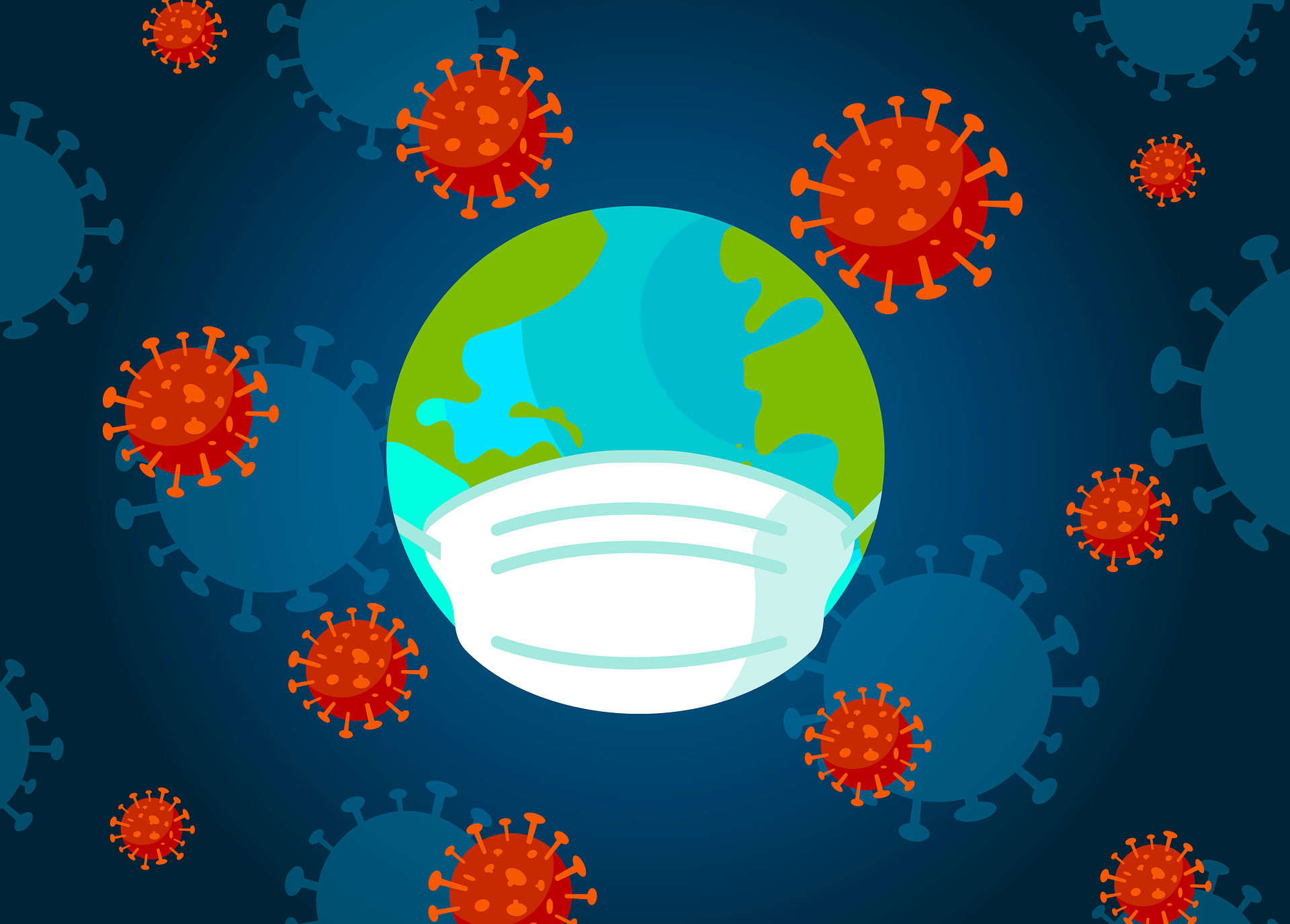
Droplet, aerosols, or both?
Researchers, public health practitioners, and policymakers have been chasing the epidemiology of SARS-CoV-2, the virus that causes COVID-19, ever since a cluster of pneumonia cases were reported in Wuhan (December 31, 2019). How does transmission occur—via droplet or aerosol (or both)? This question happens to be a hotly debated academic research topic, especially when it comes to droplet/aerosol size. After all, this information guides policy, especially around universal masking by helping us understand if masking is effective to stop transmission.
For the sake of brevity, here is an (over) simplified summary setting the stage:
Respiratory viruses, in general, may be transmitted via three routes—through contact (fomite), droplet, and aerosol. SARS-CoV-2, a viral pathogen, is primarily spread through respiratory droplets produced when an infected person coughs, sneezes, talks (or sings!) when in close contact with another person (an existing notion puts an “exclusion zone” at 2 meters, or roughly 6 feet, from an infected person).
Respiratory droplet size is on a spectrum; in the case of SARS-CoV-2, droplets can be classified as large, small, or even tiny. Water in mucus evaporates quickly, decreasing droplet size to the “aerosol” (tiny) size range. Large droplets do not remain in the air for very long (several minutes), while the aerosol ones remain for longer (potentially hours). So called “aerosolized” (“airborne”) transmission occurs via aerosol droplets, while “droplet” transmission occurs with large or small droplets.
Droplet size, however, is only part of the equation and there are many many factors that affect disease transmission. To put this information into practice, based on current supporting evidence, masking—including cloth face coverings—serves as source control, helping prevent larger droplets from evaporating into smaller ones and then into tinier ones (the lingering and traveling aerosols).
The Severe Acute Respiratory Syndrome (SARS) epidemic in 2003 was mainly spread person to person by respiratory droplets (and fomites). Current consensus indicates this may also be true for SARS-CoV-2. However, it may also be true that SARS-CoV-2 is transmitted via aerosols from respiratory droplets. A study published in PNAS identified airborne transmission as the “dominant route for spread” but due to “multiple methodology flaws” a letter signed by nearly 50 academic researchers called for its immediate retraction. Other studies (published in Emerging Infectious Disease and New England Journal of Medicine) have demonstrated the survival of SARS-CoV-2 in aerosol form in the laboratory setting.
However, these studies may not represent transmission correctly. Otto Yang, professor at the David Geffen School of Medicine at the University of California, said in an interview to Live Science that artificial aerosol machines likely generate way more aerosols than a normal person would produce. He added that it was likely an extremely concentrated virus was also used—likely more concentrated than a human would generate. SARS was also demonstrated to be in aerosol form in the same study. “We already know that the original SARS virus was not transmitted that way," in the general public, so that makes their model "not very believable,” says Yang.
CDC
New England Journal of Medicine
Mask shortages and social responsibility
While the jury is still out for aerosolized transmission among the general population, this is not the case for medical workers. Medical workers who perform aerosolizing procedures, such as intubations and nebulizations, were and continue to be most at risk for airborne transmission. This differing level of risk among these two groups was reflected in public health guidance around masking.
Initially, both the Centers for Disease Control and Prevention (CDC) and the World Health Organization (WHO) discouraged healthy people—not working in medical settings or those not serving as a caregiver to someone who is sick—from wearing masks of any kind. Reasons cited stemmed from a lack of definitive scientific evidence on mask effectiveness, given case distributions at the time, as well as protecting the supply of medical grade masks for the medical community—which due to supply chain issues, was in short supply. Further, there was concern that masks may give people a false sense of security resulting in inadvertent hand contamination during improper mask removal and lead to the neglect of other, perhaps more effective measures, such as hand washing (one study published in July indicates this latter concern may be unfounded).
Meanwhile, ahead of recommendations and mandates, people were still buying and wearing masks. After all, the world was in the throes of a pandemic caused by a respiratory pathogen. The U.S., among other countries, were running out of medical masks. Compulsive mask purchasing led to the U.S. Surgeon General sending the infamous Tweet begging people to stop buying masks.
While the U.S. had not seen a pandemic of this scale since the 1918 Spanish Flu (where masking was widespread), East Asia, particularly Hong Kong, had the SARS epidemic of 2002-2003 fresh in their memories. As reported in Time, this event may have helped shape the local etiquette of mask wearing (largely surgical masks). It was customary for East Asian populations to mask for a variety of sociocultural reasons in addition to medical reasons. Masks are worn when sick to protect others from infection. Coughing and sneezing openly is impolite: It is considered selfish not to mask, indicating one has a “low civic responsibility.” Masks were also worn to protect against air pollution, hide swollen lips or red noses, to keep warm during winter months, and even worn as fashion statements (apparently, Hello Kitty was all the rage).
Was masking effective with the SARS epidemic? The evidence is unclear as there were multiple public health interventions that simultaneously went into play such as identifying and isolating patients, quarantining close contacts, and social distancing measures. Teasing out masking independently was not possible in the community setting. However, a recent Lancet study, published June 2020, suggests masking (of varying types) may have reduced infection transmission in the community setting.
Annals of Internal Medicine
Live Science
It all counts
Face masks became mandatory in Wuhan on January 22, 2020 and many other countries followed suit at varying times. While issuing masking mandates abroad is more commonplace, issuing mandates—or even just guidelines—in the US is not as simple, even with scientific support. In an interview to NPR, public health academics said governments weighed in on the likelihood of public buy-in before issuing guidelines. Lawrence Gostin, professor of global health law at Georgetown University and director of the World Health Organization Center on National & Global Health Law, said “America is fiercely individualistic.”
The CDC recommended universal masking with cloth face coverings on April 3, 2020. This recommendation followed building evidence indicating that those presymptomatic and asymptomatic for COVID-19 can spread the virus, along with evidence of increasing and widespread transmission across the country. The WHO recommended non-medical masking (face coverings) on June 5 after additional studies further built support that masking (of varying material) was providing some source control against COVID-19. Both the CDC and WHO maintained that masking should only be used in conjunction with other public health strategies.
In Minnesota, Governor Walz issued an executive order on July 25 mandating face coverings. Now that over half of the states have masking mandates, how can we determine the efficacy of masking?
An interesting case study from the current pandemic may help offer support for masking. Over 100 people (wearing various types of masks) in a Missouri hair salon, who were in close contact with an infected hairdresser (who wore a cloth face covering), did not end up with COVID-19. However, like with SARS in 2003, it will be difficult to know for sure. According to David Hui, a respiratory medicine expert at the Chinese University of Hong Kong, “lack of solid evidence against mask wearing is not a reason to dismiss use, because there may never be scientific proof.” From masking (or cloth face covering), to handwashing, social distancing, staying home when sick—all of it counts as we battle the COVID-19 pandemic, working to slow its spread—regardless of the size of its infectious droplets.
